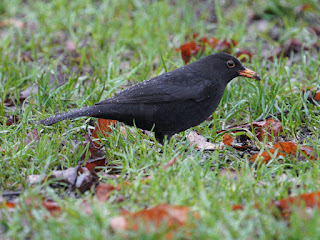The day started with sunny intervals, picking out the colours of a Starling in the leaf yard.
A pair of Egyptian Geese sat comfortably on a sawn-off tree.
Two Robins beside the Long Water, separate all winter, haven't paired up again yet but at least they have stopped trying to kill each other.
Song Thrushes have started singing all around the Long Water.
Another finely marked Feral Pigeon like the one I photographed yesterday. It was preening beside the Serpentine. Pigeon fanciers give all the colour varieties names, and this one is called Blue Grizzle.
A Long-Tailed Tit was waiting for a place at at the feeder in the Dell.
A Great Tit waited for me to feed it at the bridge.
Drizzle started around noon, then developed into heavy rain. Blackbirds welcome rain, which brings up worms ...
... and so do Mistle Thrushes ...
... but Jays look sad and bedraggled.
A Grey Heron was sitting down in the nest at the west end of the island. I've seen it sitting here several times now. Hard to tell whether it's beginning to get broody.
A heron posed among the urns in the Italian Garden.
The Moorhens here produced two broods last summer. An older one now has a red and yellow bill almost as bright as its parent's ...
... but a younger one is still in drab teenage colours.
Mute Swans toiled to gain height to fly over the bridge.













Tomorrow could be a good day to see the peregrines in the air. One or both birds have been showing up a little after 2 pm the last few days I've gone out for a look, mostly flying low-ish over the eastern end of the park from Speaker's Corner to Hyde Park Corner. Haven't seen the really spectacular display flights yet, but hopefully that's soon to come.
ReplyDeleteYesterday the tiercel was sitting up on the southwest wing of the Park Lane Hilton for over half an hour. I hope they'll finally find a ledge that allows them to keep the eggs together. I don't think this pair has nested successfully - at least not since I first saw them back in 2016.
If only the soldiers could be persuaded to put a nest box on the tower. I've seen the Peregrines mating on that ledge.
DeleteIsn't it amazing how beautiful homely, everyday birds such as pigeons and starlings are?
ReplyDeleteIt looks like swans like to flight in formation. Perhaps they find flying easier when they are in the wake of another bird, like geese?
(BTW: just found that the collective noun for a group of vultures is "a wake of vultures"!).
The migrating species of swans certainly fly in a V formation, and I think that Mute Swans do too -- I've often seen them in a diagonal line anyway.
DeleteVery appropriate word for a group of vultures. A pity that these picturesque terms are so little used.
Very interesting Natural History talk yesterday on "Bird Flight & Cooperative Aerodynamics" by the LNHS (London Natural History Society) that can be seen on their youtube video channel
DeleteMany thanks. Will look it up. The link is
Deletehttps://www.youtube.com/watch?v=oK0Wlg0tJQU.
Beautiful shot of the Starling's winter plumage in good light & love the cosy intimacy of the Egyptian Geese- an unusual shot of this ever increasing species.
ReplyDeleteIt's pleasant to see the noisy Egyptians having a moment of calm. The more they increase, the more they need to yell at each other.
Delete